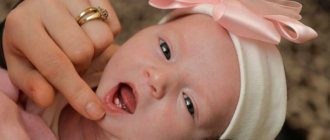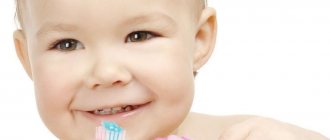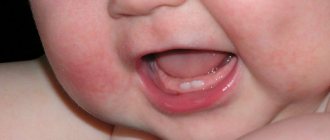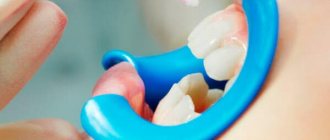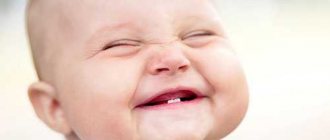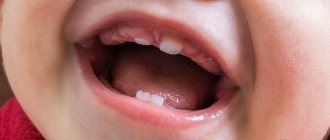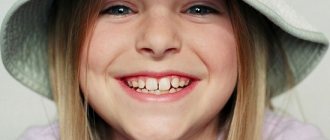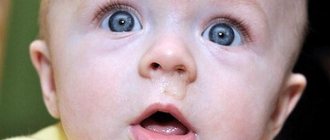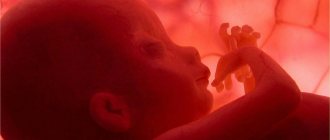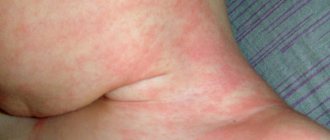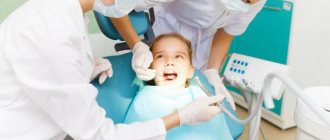What then?
But what to do with the tooth after it has been “turned” into a coin? Some parents keep them as sentimental keepsakes, but many simply throw them away, unaware of the consequences. Have you ever wondered what you can do with your child's baby tooth? Well, as it turns out, quite a lot.
According to a 2003 study by the National Institutes of Health, a child's teeth are a rich source of stem cells. This means that if in the future your baby needs replacement tissue for some reason, it will be possible to grow it using stem cells. Saving baby teeth can save lives and help repair damaged tissue.
Professional oral hygiene and fissure sealing
— For a child who is two years old, when should fissure sealing be done? What effect will professional hygiene have at this age? Is fluoridation necessary for prevention? We brush our child’s teeth at home twice a day, no problems.
— I.V.: Fissure sealing is a manipulation that is carried out strictly according to indications. These are deep, frequently located fissures on the surface of the tooth, thin enamel on the chewing surface, damage by initial caries on other surfaces of the tooth, and poor regular dental hygiene. Fissure sealing can be done if the tooth has fully erupted and the child is ready to cooperate.
Professional dental hygiene is, first of all, high-quality plaque removal. It helps remove biofilm from organisms from the surface of the teeth, gives a clean and polishes the surface of the teeth so that plaque accumulates less on them. And the final stage of professional hygiene is the application of preparations to strengthen the enamel. This helps maintain the child’s enamel in good condition and prevent caries.
Fluoride preparations are used in these procedures. You need to understand that fluoride, which parents are often afraid of, and fluoride compounds are two different things. Fluorine itself is very active, and we will never see it in its pure form. In the form of compounds, fluoride is very well integrated into the structure of the enamel, making it stronger, helping to establish the acid-base balance in the oral cavity and reducing the development of pathogenic flora in the future. In addition, in our city we drink water that is deficient in fluoride, so everyone needs fluorides to strengthen their enamel—children, for sure.
— Please tell me how effective fissure sealing is and how long does it last?
— I.V.: Above we already talked about the effectiveness of sealing. And no dentist can answer the question of how long the sealant will remain in the fissures, because this period can range from 2 to 8 years. It all depends on the quality of the procedure performed, methods, materials and professionalism of the doctor. There are quite a lot of sealants on the dental market, they have different degrees of abrasion. When sealing, strict isolation from saliva is very important. If the child is restless, it can be difficult to perform the procedure correctly. But if everything is done correctly, the sealant can last on the teeth for 8 or 10 years. Unless, of course, the child chews Lego or cracks nuts, then the sealant may chip, and this will harm the enamel. At preventive appointments, the doctor will be able to determine whether the sealant needs to be renewed.
— At what age can you do professional hygiene?
— I.V.: if the doctor sees the intensity of plaque during the examination of the baby, professional hygiene can be carried out annually. You can do this later: at one and a half, two or two and a half years, when the primary bite is fully formed. But, I repeat, a lot depends on the child: he should not be afraid of the doctor and manipulations in the oral cavity.
— The child is 2.5 years old, is it possible to do professional hygiene at this age? How long does it last?
— I.V.: The child will spend from 15 to 20 minutes in the dentist’s chair. During this period, the child’s adaptation is included - meeting the doctor and telling him how the instruments work, how the water flows, and so on.
— Please tell us more about fissure sealing for children of all ages.
— I.V.: We have also already answered most of these questions, but let’s dwell on the stages of fissure sealing. First of all, you should not perceive sealing as a panacea, because it is carried out on the chewing surface of the teeth. If hygiene is poor, caries may still appear on the side surfaces. Therefore, we carefully take care of our teeth, visit the dentist for professional examinations and control the integrity of the sealant every three months.
The procedure itself consists of the following stages: first, hygiene is carried out with a professional brush and paste, treatment with an antiseptic solution and drying of the tooth. After this, a sealant is introduced into the fissures, which hardens under the light of a special lamp, then grinding and polishing occurs. After this procedure, you can eat and drink immediately.
We recommend sealing for children aged about 6 years on newly erupted permanent teeth. Closer to adolescence, these are the seventh molars with a large network of fissures. Milk teeth, “fours” and “fives”, can also be sealed if there are indications for this: high intensity of caries in the primary dentition. The cost of this procedure is two times cheaper than caries treatment.
Traditions of the countries of the world
Each country has its own traditions. However, the most popular of them is the story about the “tooth fairy”. According to Scandinavian culture, a child's tooth brings good luck. And this is true, but, most likely, not in a magical, but in a medical sense. Modern medicine offers amazing uses for it in the treatment of many diseases.
What awaits us: doctors spoke about alarming symptoms during vaccination against COVID-19
I no longer use store-bought conditioner: my homemade product makes my clothes soft
Swedish scientists believe that the body develops immunity to Covid-19
Smell from the mouth
— Why does my two-year-old periodically have a strange smell from his breath? There are no problems with the stomach, we brush our teeth twice a day.
— I.V.: Bad breath in a two-year-old child may be a consequence of slow saliva production. We need to figure out when parents smell this smell. If the smell appears only in the morning after sleep, then most likely the smell is associated with slow secretion of saliva. Then it is physiological and does not require treatment, you just need to humidify the air in the room.
And if the smell occurs periodically and at different times, then the unpleasant odor may be a consequence of dental diseases - and this can be checked by a dentist. This may be due to the eruption of chewing teeth - molars: when the tooth erupts, it is partially covered by the gum, where pieces of food can remain, and this gives an unpleasant odor. This can occur due to diseases of the respiratory tract or ENT organs, proliferation of adenoid tissue, liver and kidney diseases, inflammation of the parotid salivary glands - but only if the smell is constantly present. Also, the smell may appear periodically after severe nervous tension, which affects saliva production.
Insufficient quality oral hygiene at home can also be the cause of the odor: if food gets stuck somewhere between the teeth and the mother cannot clean it out because the baby does not allow her to see her mouth well. In addition, it is worth observing: maybe the bad breath is associated with the consumption of certain foods.
The “secret” of baby teeth
Stem cells can be stored for many years and used in the treatment of all sorts of diseases already in adulthood. Researchers have repeatedly proven that stem cells are indispensable for maintaining human health and life. They can repair and replace other damaged cells. It turns out that exchanging a tooth for a modest gift for a child is beneficial. But don’t throw away such a “present” from your baby. In the future, doctors can regenerate all types of damaged tissue from baby teeth for your child - from heart cells to brain cells.
But there's one catch! Over time, stem cells can lose their properties, so your child's teeth should be fresh and taken to a special laboratory that keeps them in good condition. If the child needs these cells in the future, the teeth will be immediately delivered from the warehouse to the attending physician.
Many dental clinics are already thinking about introducing a service such as storing and delivering teeth from the patient to a special warehouse. This will improve the quality of medical care provided.
Found a violation? Report content
Home care for children's teeth
— For a 3-year-old child, which toothpaste should be preferred (if there has already been caries, has been treated, there are problems with the enamel) — ROCS PRO Kids “Wild Berries” with xylitol without fluoride, or toothpastes with amine fluoride Elmex and Lacalut?
— I.V.: Of those listed, I would give preference to Elmex and Lacalut pastes. If a child under 3 years of age has already had caries treated and has problems with enamel, we can conclude that his tooth enamel lacks microelements, which means he needs a paste with a certain strengthening component. ROCS PRO Kids paste contains an additive that inhibits the proliferation of pathogenic bacteria, but does not provide any strengthening for the enamel. And the other two pastes contain active fluoride compounds that strengthen the enamel.
— At what age can a child brush his teeth with an electric brush? What parameters should you pay attention to when choosing an electric brush?
— I.V.: You can try brushing your child’s teeth with an electric brush at any age, although the average recommended age is 3 years. But it is possible earlier if the child does not mind and is not afraid of the sounds of the brush. The first thing you need to focus on is the child’s mood. If he is ready, try at one and a half and two years. We recommend that many of our patients use an electric brush for “general cleaning” of the oral cavity.
We can give him a brush to play with so that he adapts to it, but we must understand that his parents brush his teeth. You need to use such a brush correctly: the parent controls the movements and pressure on the toothbrush, bringing the brush alternately to each of the teeth. At appointments, we show parents how to use the brush so that it is all for the good.
Choosing a brush can take a very long time. There are more affordable battery-powered models - they are less powerful. Battery brushes are more powerful, more expensive and easier to use. Usually they have a pressure sensor, a time sensor. There are even special children's toothbrushes that can be used from the moment the first tooth appears. These are brushes with minimal pressure and soft bristles.
— At what age can you use an irrigator and how often? For a 2.2 year old child, what is the best way (and is it necessary) to clean the interdental spaces?
- I.V.: There are two options for cleaning dental spaces: irrigators and dental floss - it all depends on the convenience and skills of the parents. Dentists treat irrigators well, but there are also requirements for the child: he must be able to rinse his mouth and spit out liquid, so irrigators are usually recommended for children from three years of age. The requirements for a children's irrigator are minimum water pressure. During examinations, we see much less plaque in children who use an irrigator than in children who do not use it.
— Question about toothpaste: 10 years ago, many dentists recommended giving up toothpastes with fluoride, but now they are even recommended for children, what is the reason for such changes? At what age is it safe to brush your child’s teeth with fluoride toothpaste? There is an opinion that toothpastes in the mass market have a negligible fluoride content and it does not have any positive effect on the condition of teeth.
— I.V.: Fluorine, as we have already said, is present in toothpastes and other dental materials in compounds - these are fluorides. They suppress the growth and reproduction of bacteria that cause caries, normalize the acid-base balance in the oral cavity, and form hydroxyfluorapatites in tooth enamel - this is the strongest compound in our body. They also participate in increasing local immunity in the oral cavity and reduce the formation of dental plaque.
Such toothpastes are recommended for children who have problems with tooth enamel or a high level of caries in the oral cavity. And if a child has caries on more than half of his teeth, he is prescribed a toothpaste with an even higher fluoride content. Pastes with fluoride can be used from the age of one year: we take a very small amount of paste, the size of a grain of rice, and the child should not eat the paste. Therefore, parents brush their child’s teeth and wipe them immediately.
— Question about the softness of the bristles. Our dentist recommended that the whole family use brushes with soft bristles, so that all the bristles are the same length, even, without rubber inserts, etc. I would like to hear the dentist’s opinion on what kind of toothbrush should be.
— I.V.: Indeed, a children’s brush should not be hard and multi-leveled. Silicone inserts are also not needed. The bristles should not be very long: with long bristles, the activity of cleaning movements is lost. When choosing a brush, pay attention to the handle: it should be comfortable. If a child brushes his teeth himself, it should be comfortable for his hand. If parents brush a child’s teeth, it’s for the parent’s hand.
— Which toothpaste do you prefer and why (4 year old child)? And what do you think about the gel “ROCS medical, remineralizing gel for children and adolescents”? Is it worth using it for prevention?
— I.V.: You can use gel, but it is not a magic ointment that will stop incipient caries. ROCS medical gel is good and affordable, there is also GC Tooth Mousse with an almost identical composition, but in a slightly different form: one gel is thicker, the other is thinner.
— When, how and with what should you start brushing your baby’s teeth?
— I.V.: You should start brushing your teeth from the moment the first tooth erupts, waiting until the tooth is free from the gum. I most often recommend Biorepair or Montcarotte paste to my patients.
— How to brush the first teeth of a 5-6 month old baby who is on breast milk and complementary foods from jars? What brushes and pastes should I use, how many times a day should I clean?
— I.V.: We have already said that Biorepair or Montcarotte pastes are suitable for babies; they do not contain fluoride, but do contain calcium. Choose a brush with soft bristles for children aged 0 to 3 years, as silicone fingertips do not clean teeth effectively. We brush the child’s teeth with sweeping movements; the time required to brush the baby’s teeth is literally 30 seconds. At the stage of habit formation, I recommend brushing your teeth at a time when the child is cheerful and cheerful, and in the mood to play. In the future, we will teach the child to brush his teeth at night and in the morning after breakfast.
In the meantime, choose a time when your child thinks brushing his teeth is a good thing, like playing with a rattle. We take a tiny pea of paste for two teeth: imagine if there were 20 teeth, we would take a lump of paste the size of a grain of rice. We brush our teeth and then, so as not to worry that the child will swallow the toothpaste, you can wipe the teeth with a cotton pad moistened with boiled water. After this, rinse the brush with boiled warm water and set it to dry in an upright position, isolated from adult toothbrushes. You can also use wet wipes for children of this age, for example, Asepta Baby, which contain xylitol; mothers wipe their children’s teeth with them so that they are strong and durable.
